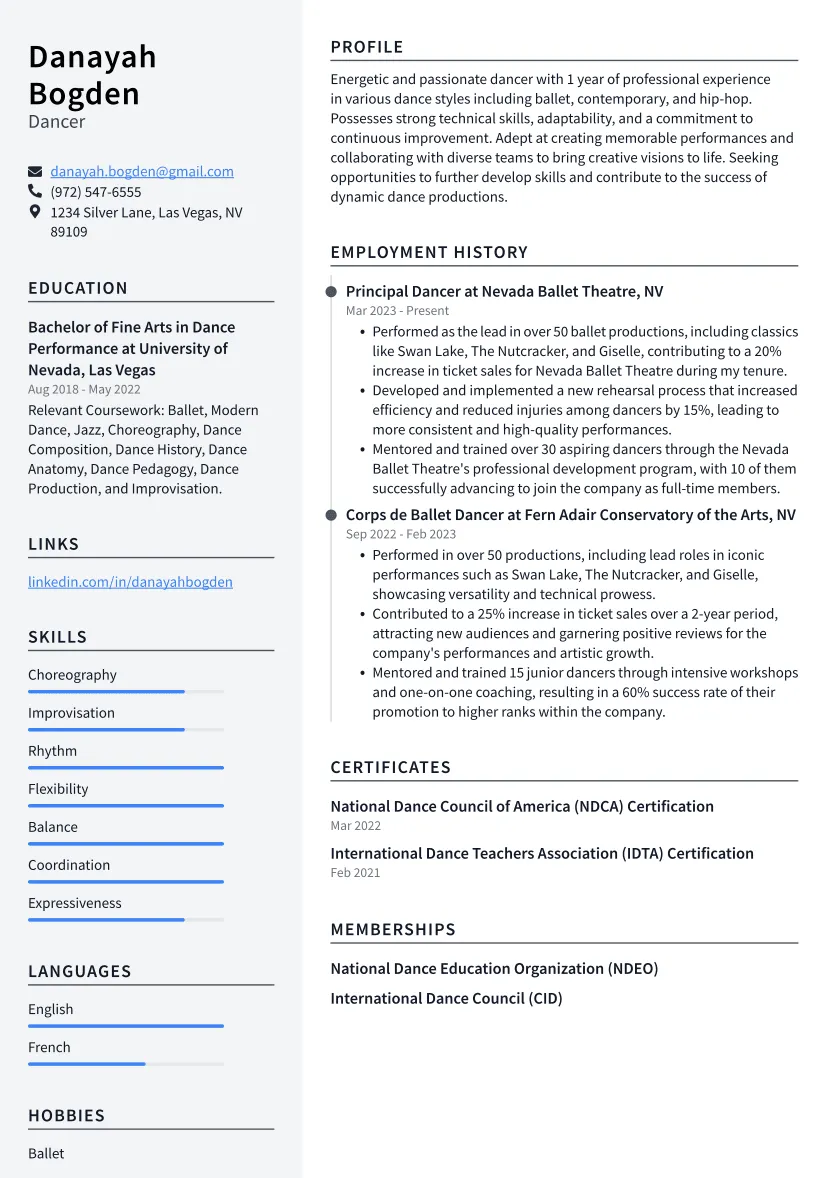What Is a Dance Cover Letter
A dance cover letter is a crucial document that accompanies your dance resume when applying for dance positions, auditions, or programs. It serves as your personal introduction, allowing you to showcase your unique qualifications, passion for dance, and suitability for the specific opportunity. Unlike a resume, which provides a factual overview of your experience, a cover letter gives you the space to elaborate on your skills, express your personality, and demonstrate why you are the ideal candidate. It’s your chance to make a strong first impression and persuade the recipient to invite you to the next stage of the selection process. Think of it as your opportunity to tell a story about why you are perfect for the dance role.
Why Is a Dance Cover Letter Important
A well-crafted dance cover letter is essential for several reasons. Firstly, it provides context to your resume. While your resume lists your achievements, the cover letter explains how those achievements align with the specific requirements of the position or program. Secondly, it allows you to highlight your passion for dance and your commitment to the art form. This enthusiasm can set you apart from other applicants who may have similar qualifications. Thirdly, a cover letter demonstrates your communication skills, attention to detail, and professionalism, all of which are highly valued in the dance world. Lastly, it gives you the opportunity to address any potential gaps in your experience or explain unique circumstances that might be relevant to your application.
Key Components of a Dance Cover Letter
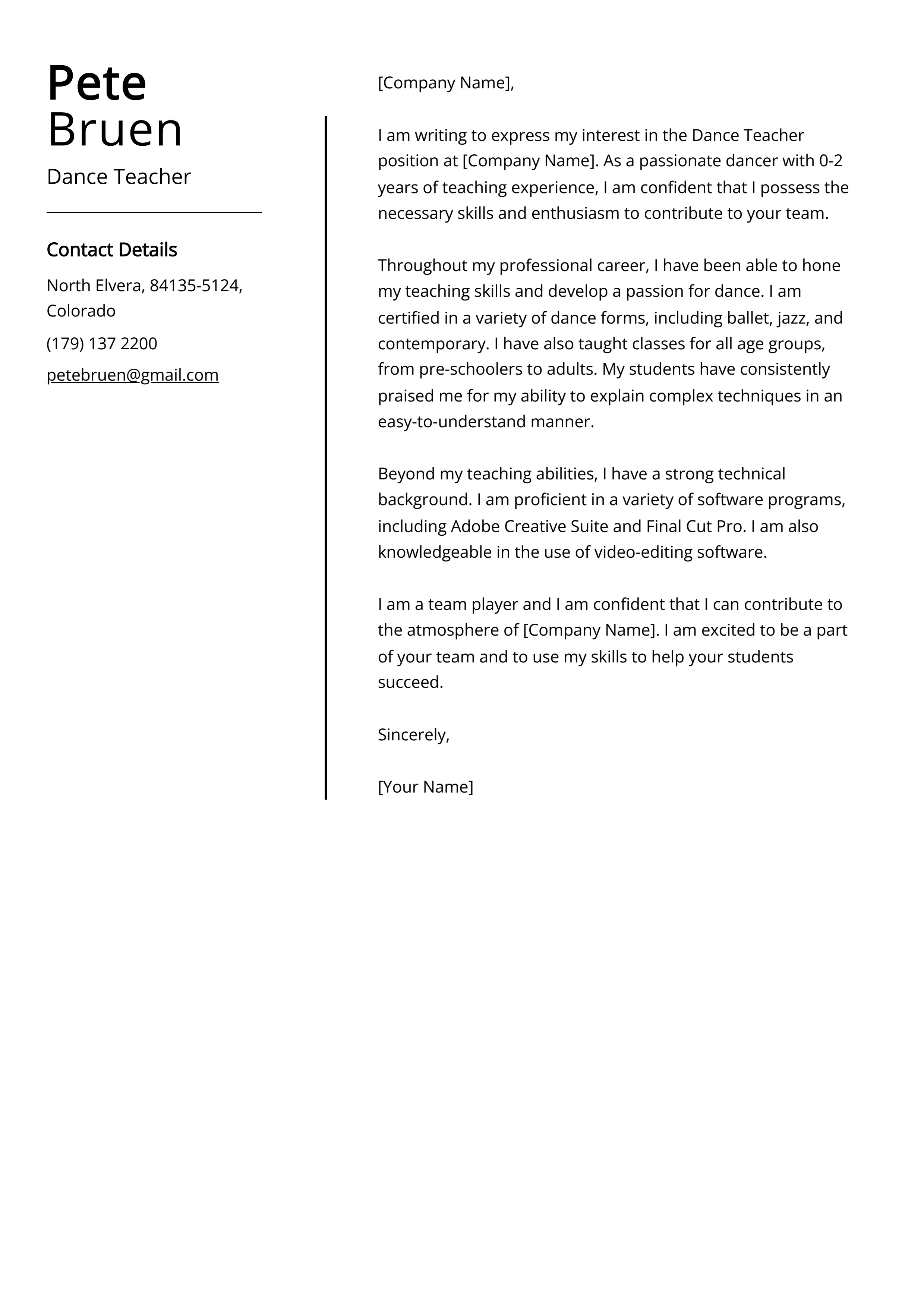
A successful dance cover letter typically includes several key components, each serving a specific purpose in conveying your message effectively. These components, when combined, create a compelling narrative that highlights your skills, experience, and passion for dance. Understanding these elements is crucial for crafting a cover letter that grabs the reader’s attention and increases your chances of securing an audition or job offer. A well-structured cover letter not only showcases your abilities but also demonstrates your professionalism and attention to detail, qualities highly valued in the competitive world of dance. Carefully consider each section and how it contributes to your overall presentation.
Contact Information & Salutation
Begin with your full name, address, phone number, and email address at the top of the letter. Include the date and the recipient’s name, title, and address. Use a professional salutation, such as “Dear Mr./Ms./Mx. [Last Name]” or “To Whom It May Concern” if you don’t know the hiring manager’s name. Ensure the salutation is respectful and aligns with professional etiquette. This sets the tone for the rest of the letter and shows you’ve taken the time to address it appropriately. If possible, research the name of the person in charge of hiring, as a personalized salutation is always preferred.
Body Paragraphs
The body of your dance cover letter is where you make your case. Start with a strong opening statement that grabs the reader’s attention and clearly states the purpose of your letter, mentioning the specific position or opportunity you are applying for. The body paragraphs should elaborate on your skills and experience, highlighting how they align with the requirements of the role. Provide specific examples from your past experiences to illustrate your abilities. Maintain a clear and concise writing style, using action verbs to describe your accomplishments. Be sure to express your enthusiasm for the opportunity and the organization, demonstrating that you have researched and understand what they are looking for.
Highlighting Your Skills & Experience
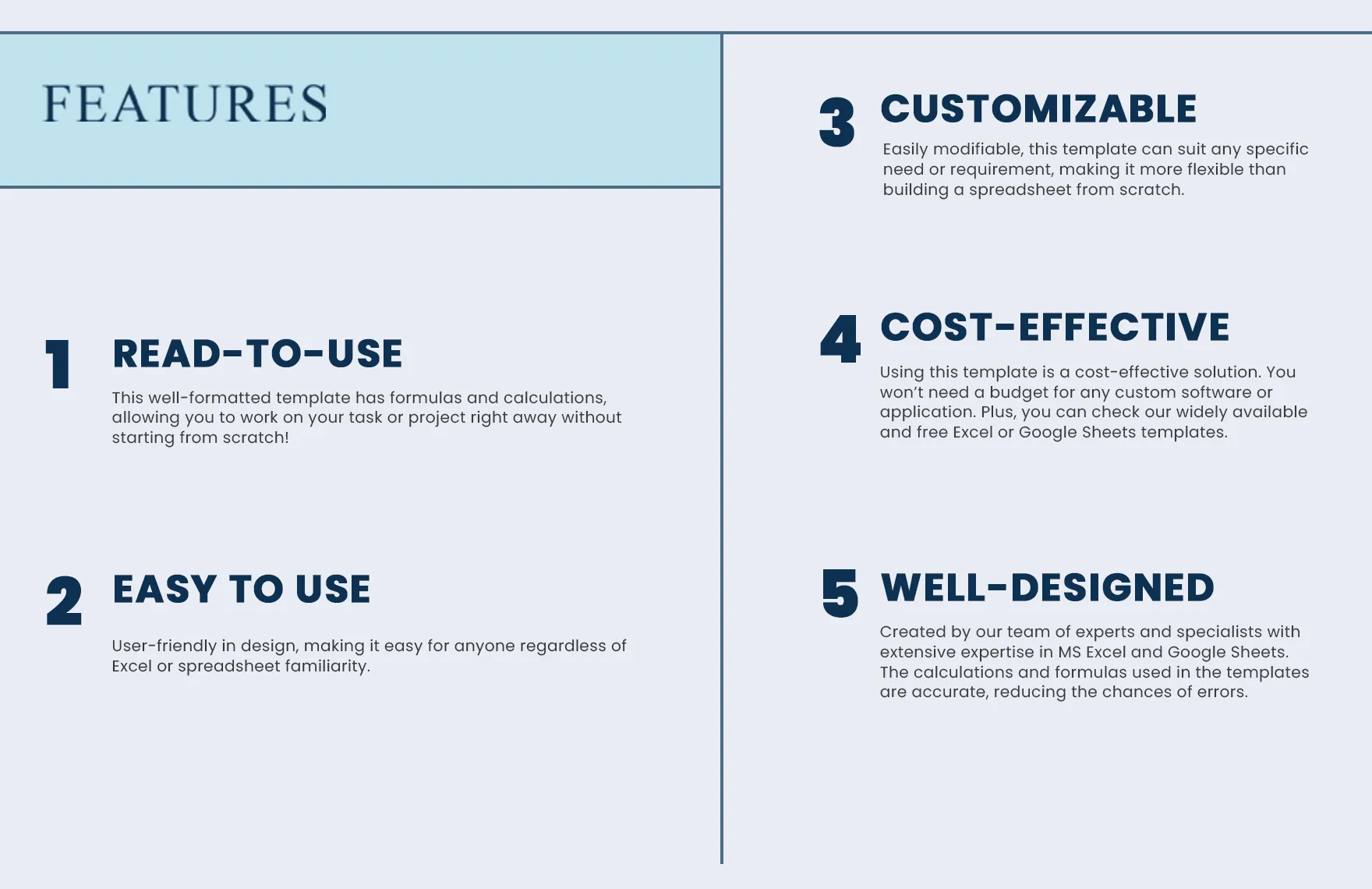
Focus on the skills and experiences that are most relevant to the position. Tailor your cover letter to each application by carefully reviewing the job description and highlighting the skills and experiences that the employer is seeking. Mention your training, including the schools or studios you attended, the techniques you are proficient in (ballet, contemporary, jazz, etc.), and any certifications or awards you have received. Provide examples of your performances, including the roles you played and the companies you danced with. Quantify your achievements whenever possible (e.g., “performed in over 50 shows,” “taught ballet to 20 students”). Use action verbs to describe your accomplishments.
Showcasing Your Passion & Personality
While it’s important to be professional, your cover letter is also an opportunity to let your personality shine through. Express your passion for dance and explain why you are drawn to the specific opportunity or organization. Share what excites you about the prospect of working in this particular environment, whether it’s the company’s artistic vision, the opportunity to work with specific choreographers, or the chance to contribute to a particular project. Be authentic and genuine in your writing, showing the reader what makes you unique. Your enthusiasm can make a lasting impression, helping you stand out from other candidates. Avoid generic statements and instead, provide specific examples that illustrate your passion and commitment to dance. This adds a personal touch that resonates with the hiring manager.
Tailoring Your Letter to the Specific Role
Avoid sending generic cover letters. Customize each letter to the specific position and organization you are applying to. Research the company or program to understand their values, artistic vision, and the type of dancers they are looking for. Refer to specific aspects of the job description and explain how your skills and experience align with those requirements. Mention any relevant projects or performances that showcase your ability to meet their needs. Tailoring your letter demonstrates that you have taken the time to understand the opportunity and that you are genuinely interested in the role. This level of detail shows initiative and commitment.
Call to Action & Closing

End your cover letter with a clear call to action. State your interest in an audition or interview, and express your availability. Thank the reader for their time and consideration. Use a professional closing, such as “Sincerely” or “Best regards,” followed by your typed name. Consider including a link to your online portfolio or dance reel, if applicable. Ensure your contact information is readily available. Proofread your letter carefully before submitting it. A well-crafted call to action encourages the recipient to take the next step, moving your application forward.
Dance Cover Letter Examples
These examples provide templates to inspire your own cover letter. Modify them as needed to align with your particular experience and the specific role you seek.
Example 1 Contemporary Dance
Dear [Hiring Manager Name],
I am writing to express my keen interest in the Contemporary Dancer position at [Dance Company Name], as advertised on [Platform]. Having followed [Dance Company Name]’s innovative work for years, I am deeply impressed by your commitment to pushing the boundaries of contemporary dance. My training at [Dance School Name], coupled with my experience in [Specific Contemporary Techniques] and performances with [Dance Troupe Name], have equipped me with a strong foundation in both technical proficiency and artistic expression. In my previous role, I was responsible for choreographing several pieces for [Performance Name], which included collaborating with other dancers, managing rehearsals, and maintaining artistic vision. I am confident I can adapt to various choreographic styles. I am eager to contribute to your company’s creative process. I am available for an audition at your earliest convenience. Thank you for your time and consideration. Sincerely, [Your Name]
Example 2 Ballet
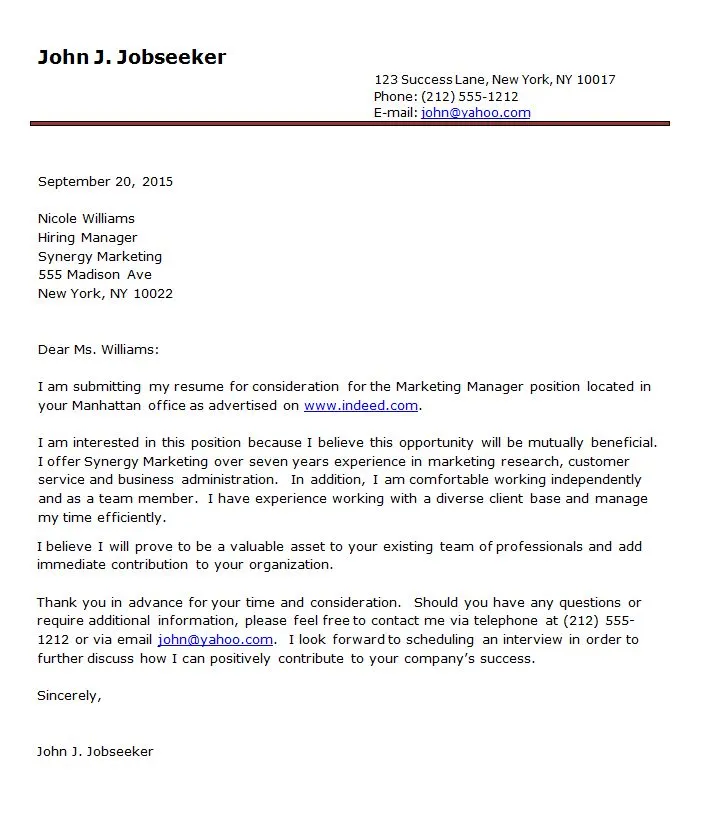
Dear [Hiring Manager Name],
I am writing to express my interest in the Ballerina position at [Ballet Company Name]. I have been a dedicated ballet dancer for over 15 years, having trained at [Ballet School Name] under the instruction of [Instructor’s Name]. My resume details my experience in classical ballet, pointe work, and variations. My experience with [Ballet Company Name] allowed me to learn valuable information about proper posture and technique. I have a proven track record of performing lead roles in classical ballets. I am confident in my ability to contribute to [Ballet Company Name]’s esteemed company. I am eager to have the opportunity to demonstrate my abilities. Thank you for your consideration. I look forward to hearing from you soon. Sincerely, [Your Name]
Example 3 Hip-Hop
Dear [Hiring Manager Name],
I am writing to apply for the Hip-Hop Dancer position at [Dance Studio/Company Name], as advertised on [Platform]. As a dedicated hip-hop dancer for [Number] years, I have honed my skills in various styles including breaking, locking, popping, and krumping. I am proficient in performing in group dance numbers and improvisational routines. Furthermore, I have experience in choreography and have been involved in community outreach programs. I am eager to contribute my skills to your team. I am confident I can bring innovative ideas to the company. Thank you for considering my application. I look forward to hearing from you soon. Sincerely, [Your Name]
Tips for a Successful Dance Cover Letter
In addition to the essential components, here are some additional tips to make your dance cover letter stand out:
Proofread Carefully
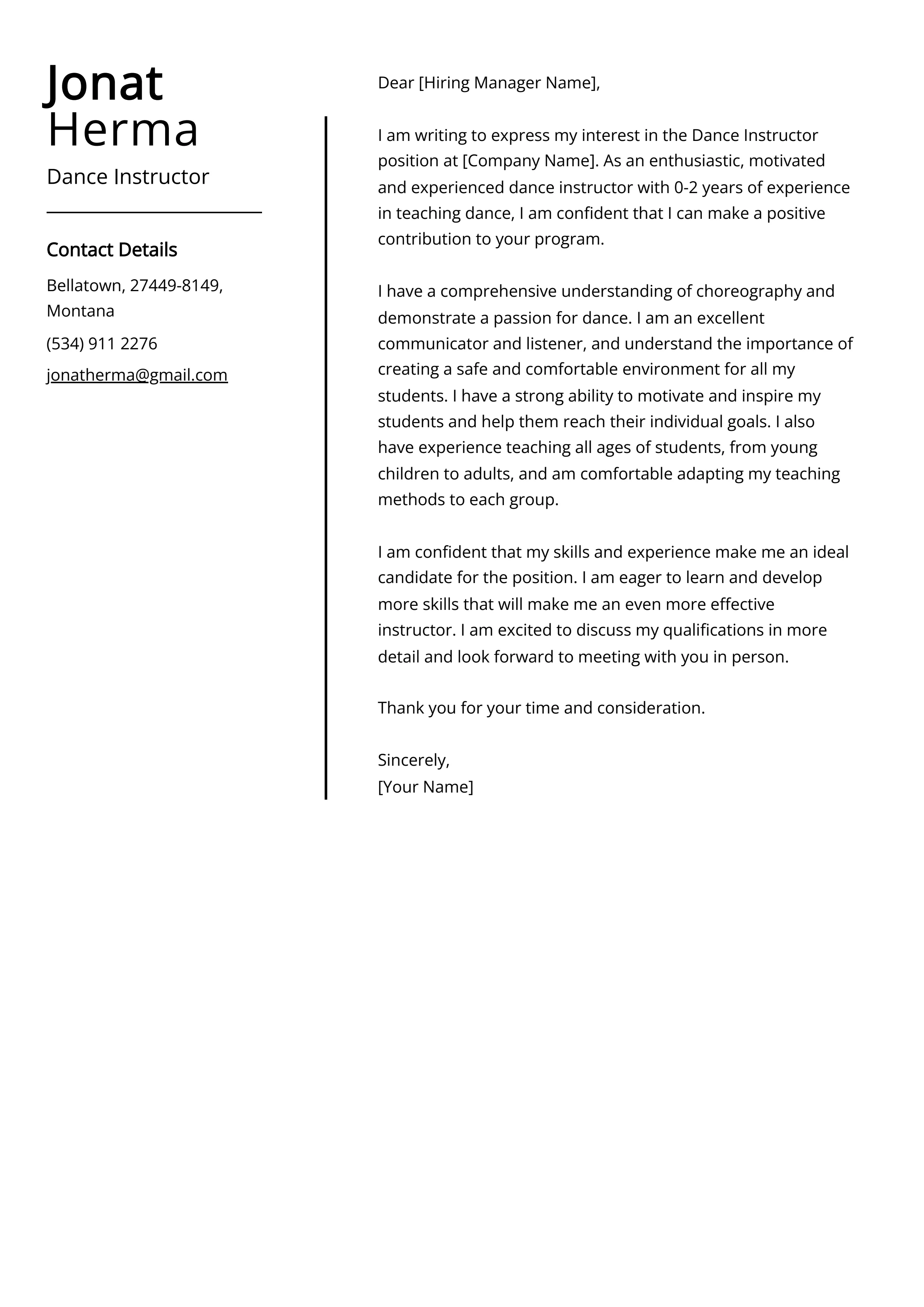
Typos and grammatical errors can undermine your professionalism. Always proofread your cover letter multiple times, and consider having someone else review it as well. A fresh pair of eyes can catch errors that you might miss. Ensure proper spelling, punctuation, and grammar throughout the document. Attention to detail is a critical trait in the dance world. Thorough proofreading demonstrates your commitment to excellence.
Use Action Verbs
Use strong action verbs to describe your skills and accomplishments. Instead of saying “I participated in,” say “I performed,” “I choreographed,” “I led,” or “I taught.” Action verbs make your cover letter more dynamic and engaging, bringing your achievements to life. Select verbs that best represent your role and your accomplishments. This will help you to make a powerful impression and showcase your capabilities in a concise and effective manner. The language should be active and assertive, highlighting your proactive approach and accomplishments.
Show, Don’t Tell
Instead of simply stating that you are a “passionate dancer,” provide examples that demonstrate your passion. For example, you could mention the number of hours you dedicate to training each week, your involvement in community dance projects, or your commitment to pursuing advanced training. Specific examples make your claims more credible and memorable. Use specific anecdotes that demonstrate your strengths and skills. The goal is to create a clear and compelling narrative that supports your qualifications and reinforces your suitability for the position.
Formatting & Presentation

The formatting of your cover letter is important for readability and professionalism. Use a clean, easy-to-read font such as Times New Roman, Arial, or Calibri, with a font size between 10 and 12 points. Use standard margins (1 inch on all sides) and single-space the text with a blank line between paragraphs. Ensure your cover letter is well-organized, with clear headings and subheadings. Save the document as a PDF to ensure that your formatting is preserved when the recipient opens it. A well-formatted letter shows that you pay attention to detail.
Cover Letter vs Resume
A dance cover letter and resume serve different purposes. Your resume provides a factual, chronological overview of your experience, including your training, performance history, and other relevant information. The cover letter complements the resume by providing context and highlighting the most relevant aspects of your qualifications for the specific opportunity. It is where you elaborate on your skills, express your passion, and demonstrate your suitability for the role. The resume is a brief summary of your accomplishments, while the cover letter is your opportunity to explain why you are the ideal candidate. The resume is the “what,” while the cover letter is the “why.”
Conclusion
A well-written dance cover letter is a powerful tool for securing dance opportunities. By following these guidelines, you can create a cover letter that effectively showcases your skills, experience, and passion for dance. Remember to tailor your letter to each specific opportunity, highlight your unique qualities, and express your enthusiasm. With careful planning and attention to detail, you can increase your chances of making a positive impression and advancing your dance career. Use the provided examples and tips to guide your writing process. Good luck, and keep dancing!
